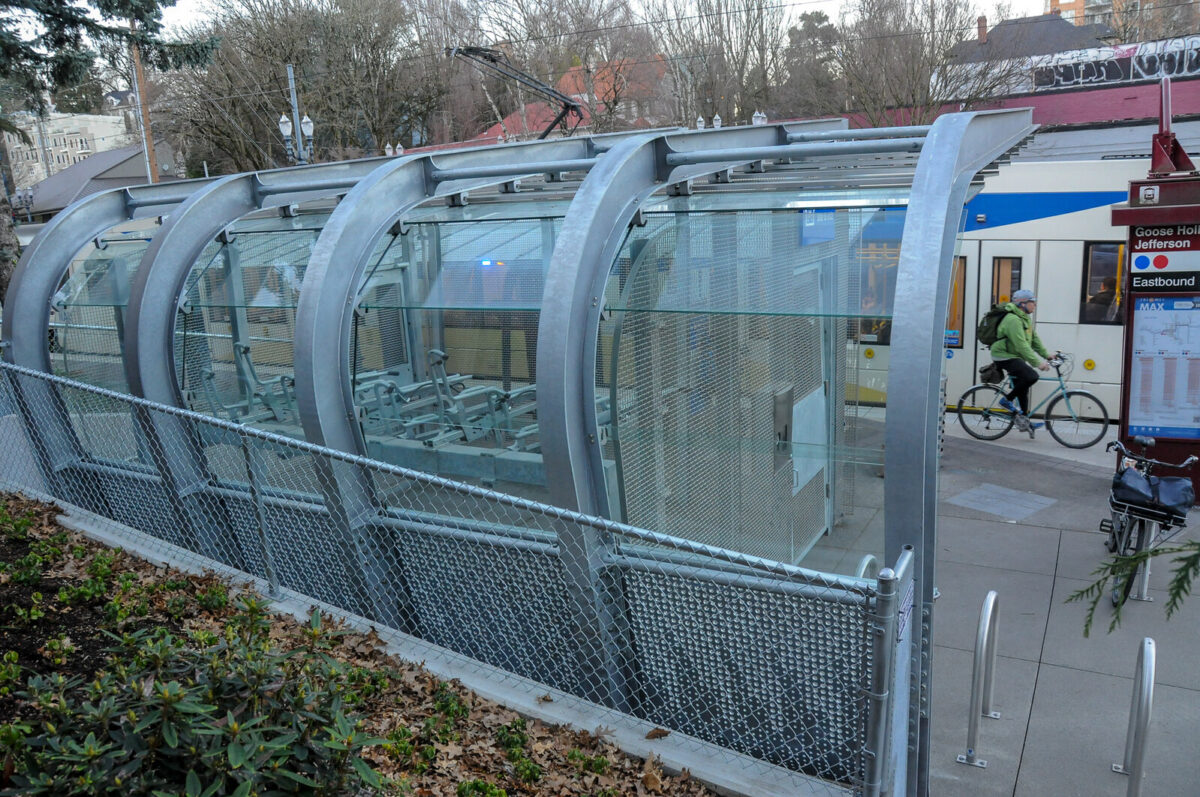
(Photo: J. Maus/BikePortland)
There’s perhaps no more important place for high-quality bicycle parking than a location where bike theft is rampant and that sits at the bottom of a big hill separating two major employment zones.
That’s why many bicycle users were excited about the new bike parking at TriMet’s Goose Hollow MAX station. Unfortunately the facility is now over a year behind schedule and remains mostly unused. Reached this morning for comment, TriMet says a technology issue is preventing them from opening the high-tech secure facilities at three stations: Goose Hollow/Jefferson Street, Beaverton Creek, and Gateway Transit Center.
“We’ve experienced technology integration challenges that we continue to work to solve.”
— Roberta Altstadt, TriMet
Two years ago we shared a guest post from TriMet Senior Planner Jeff Owen where he explained the designs and made the case that secure bike parking at Goose Hollow “plays a crucial role” in making transit work better. Coupled with a similar new facility on the west side at Beaverton Creek, the idea was for people to park their bikes on one end of their MAX trip and use another bike (or bus, walk, or use company shuttle) on the other end. This would alleviate overcrowding on trains that occurs when too many people roll bikes on board.
Reader Scott Barry is a regular bike commuter who relies on the MAX Blue Line to get between Portland and the west side. He recently shared with us that he’s seen the number of bikes on the train skyrocket in recent years. “Eight bikes on one side of the train at one time is not that uncommon,” he wrote in an email last week asking for an update on the project. And he’s even seen eight bikes on each end of the train. “It requires so much shuffling of positions that people can barely get off in time.”
TriMet finished construction of the new bike parking at Goose Hollow late last year. As we reported back in January, there are 16 spaces inside a secure metal cage and 14 spaces (seven staple racks) just outside of it.
Advertisement
Those 14 spaces are usable, but Scott says other bicycle riders he’s talked to don’t trust them. “They would never leave their bike at one of the staples outside of the cage, camera or no camera. Nobody believed the camera would make any difference, and people noted that it would be an ideal theft location because the thief would have 9 hours to plan and schedule the theft while the owner was at work.”
Given the (very reasonable) fear of theft, Scott thinks the only parking that is actually viable are the 16 spaces inside the locked cage.
It’s a common sentiment, and TriMet is racing to catch up with demand for more secure bike parking.
“We had hoped to open three new bike-and-rides by now at the the Goose Hollow/SW Jefferson Station, Beaverton Creek Station and Gateway Transit Center,” TriMet Media Relations & Communications Manager Roberta Altstadt shared with us this morning. “However, we’ve experienced technology integration challenges that we continue to work to solve.”
Specifically, that challenge is related to TriMet’s new Hop Fastpass card. In theory, the Hop card should be riders’ effortless key to the entire TriMet system — whether that means using it as a fare card or unlocking a bike parking facility. Altstadt says they’ve got it mostly working at this point, but one problem remains: How to give access to the secure bike facility if someone loses their card.
According to Altstadt, the current solution is to have the rider use a video intercom that connects to a TriMet employee to confirm his/her/their identity and then the employee could open the gate remotely. But that requires integration with TriMet’s existing IT infrastructure and other staffing and protocol issues. “We would hope that comes together soon,” Altstadt says, “but unfortunately, we do not have a timeframe.”
UPDATE, 9/9: TriMet says they’ve decided to open these facilities. Below is the statement from Altstadt:
“I have an update on the bike and rides at the Goose Hollow/SW Jefferson St Station, Beaverton Creek Station and Gateway Transit Center. While we continue to work on the technology and staffing needed for video intercoms and the ability to remotely unlock the secure facilities should someone lose their Hop Fastpass® card, we are going with a temporary, low-tech solution right now. We have opened the bike and rides up for use with Hop cards. If someone loses their Hop card with their bike locked inside the facility, they will need to contact TriMet and we will send a security officer or TriMet employee to assist them. This may be within the hour, or it could take longer.
Here is the information we sent this morning to those who have asked about using the three new bike and rides:
– Registration required: Bring your Hop card and photo ID to the TriMet Ticket Office in Pioneer Courthouse Square (M–F, 8:30 a.m.–5:30 p.m.)
– These facilities are accessible exclusively with a Hop card. If you don’t have a Hop card, you can purchase one for $3 at the ticket office.
– Lock your bike to the rack inside using a quality chain or U-lock. (You’ll need to bring your own lock.)
– There is no charge to park at these locations.We also encourage users to keep track of their Hop card, since there will be a delay getting into the bike and ride if they lose their card.
We thank those who have been wanting to use the secure bike parking facilities for their patience as we work through the details of providing a more simplified experience using our transit system with just a Hop card.”
— Jonathan Maus: (503) 706-8804, @jonathan_maus on Twitter and jonathan@bikeportland.org
Never miss a story. Sign-up for the daily BP Headlines email.
BikePortland needs your support.


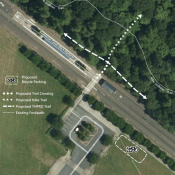
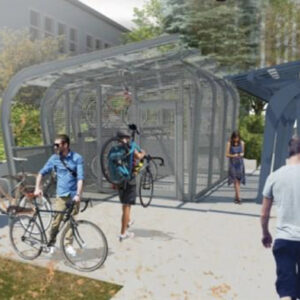
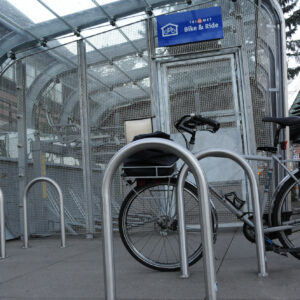
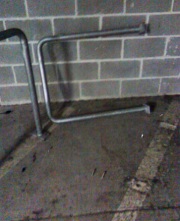
Thanks for reading.
BikePortland has served this community with independent community journalism since 2005. We rely on subscriptions from readers like you to survive. Your financial support is vital in keeping this valuable resource alive and well.
Please subscribe today to strengthen and expand our work.
Lets See, we can’t open and close the access door on a secure bike storage facility reliably under all conditions but A.I. will soon take over and replace us at our jobs and drive our cars. The real world has a way of getting in the way of our robot overlords
I’m sorry but no amount of technical wizardry will make me feel safe leaving my bike at MAX station unattended for 9 hours.
With the insane level of vagrancy and theft in these areas (Gateway, BTC) nothing short of a staffed location with 24-hr attendant would make me ok with this arrangement. I know that’s expensive but so is this waste of money no one will use.
The OHSU bike valet is really the model to follow. We shouldn’t bother spending money on secure bike parking for just 16 bikes. That is a waste. Any truly secure bike parking location should have a minimum of 100 spots, and be staffed during work hours.
Location Location Location! This site is a no brainer for 20+ years…but I was a little shocked that “they-all” settled for such a small facility (its like we are back in 2000 and the Yellow Line era bike demand is “the outcome)…the size of this facility will not really make a dent in the problem. The design and development costs are pretty steep to spread over that few bikes..in my experience (unless this was an off-the-shelf design. [Its really too bad that land was not bought there back when Trimet could afford it…they and other transit agencies…always seem to have the ability to buy lots’o’land land for car P&Rs…but not for large efficient bike P&Rs. And then they will complain it failed for being too small or too expensive to run (the access control costs the same for 10 bikes or 300 bikes) ;-(
Another desired amenity that attendants could watch over is restrooms. There’s none really near Beaverton and Freddy’s is a little ways from Gateway.
The flaws in shared parking had been well established when this was built.
Does anyone remember why this design was chosen over individual lockers in the first place?
I’m guessing lockers take up more space, and at least traditional ones can only be rented to one person, though I know on-demand lockers are possible. In addition, there may be a worry that lockers would get used to store stuff other than bikes.
You can fit 10 individual bike lockers in 1 car parking spot. Lack of space is a result of lack of imagination.
don’t lose your Hop Fastpass. Or if you do, have someone else buzz you into the cage, where presumably you have locked your bike and you can produce a key to that lock as evidence you are the owner of the bike. It works just like that at my bike cage at work.
Pretty sure only you can buzz yourself into the cage with *your* card. Otherwise, what would be the point?
If you lose your card, don’t you need to buy another one anyway. Just get a new card. Trimet’s complicated solution would only be needed if you lost your card on the last day you would ever need to use Trimet.
1 Max Car = 4 bike hooks
2 cars per MAX train = 8 bike hooks
16 ‘secure’ parking spaces = Potentially full parking cage after two full MAX trains.
14 Bike staples = Unused or used in desperation after finding the secure parking is full.
9 hours = The amount of time you sit at work wondering if your bike
Time for the West side to offer some bikeshare options beyond the employee only Nike Bikes at Beaverton Creek and Merlo Rd?
I’ve been commuting from Portland to the westside via Biketown, Max & walk for two years now. I’m fortunate enough to be able to walk to work once I reach my westside Max stop, but many aren’t. Of course, the bike infrastructure around the max stations leave much to be desired on many westside stops. The bike lanes are either disconnected or nonexistent and the speed limits are 35 mph and up around many stations.
Sure, the orange bikes are heavy, but you never have to endure a glare from someone who just oiled up their pants trying to navigate past the five bikes crammed in the entrance
— End of Bikeshare Cheerleading communique — 🙂
Goose Hollow would have made the perfect bike valet location!
Missed opportunity.
you called it Kiel. Too bad TriMet doesn’t pay to do some focus groups/feedback sessions with BikePortland readers before they have architects design stuff that people aren’t event excited to use and that their tech doesn’t work with yet.
Same could be said for PBOT.
In 2012 or so we got a federal grant through ODOT to do both buffered bike lanes on outer Division to 148th and $400,000 for secure bike parking at Gateway. 7 years later, lots of design, but no build.
As usual.
They could use a texting/code system for lost card entry. It might require some upfront coding, but could eliminate the need for an intercom system. If the user has their own “master pass code”…text to bike.locker.lostpass, receive a one time entry code. Something simple, yet common for most with smartphone access. Could work the same on a payphone.
If it were a car parking facility issue, bet itd been fixed by now. (*just my opinion).
Has Tri Met thought of connecting themselves with bikelink.org? I have used their pay-as-you-go bike lockers at home (Vancouver, WA,) in Portland, and in Eugene. They have a good system worked out. You do have to buy one of their refillable cards but the lockers work like a charm.
They are already working with BikeLink. A number of locations have the on-demand bike lockers.
Rose Quarter, Hollywood, 60th, 82nd, Gateway, 122, Cleveland, Parkrose, Cascades, Mt Hood all have BikeLink lockers. I think every stop on the west side also has them.
The only lines which do not have them are Yellow, Orange and Green.
Even if they get the tech working, it’s only a matter of time before the system fails to lock the door, or someone leaves the door open accidentally/on purpose, or someone figures out how to jam the door open, or the system fails to unlock the door, or…
On a related note, does anyone climb the Sylvan Hill on the shoulder from Goose Hollow up to the Zoo? I often ride it the other direction and am seeing more and more people doing the same. Doing so shaves quite a bit of time off of my commute when I’m in a hurry. I think climbing 26 up to the Zoo exit would also shave off quite a bit of time.
Sure, I used to commute that way regularly. Cool trivia: the path out of the zoo is a popular spot for longboarders (it’s called “Switchbacks”).
You commuted on HWY 26 in both directions from ZOO to Goose Hollow and vice versa? Did you feel safe climbing the shoulder of 26 up to the Zoo?
No, I did this: “climb the Sylvan Hill on the shoulder from Goose Hollow up to the Zoo”
But I might have misunderstood your meaning. I’m talking about riding up Jefferson to the Murray St path.
I’ve lived on the westside 18 years and have only seen someone riding up US26 once. Super sketch. Maybe she missed the Murray Street turn to go up into Washington Park?
Strava shows 341 different people have ridden the downhill section of US26 (zoo to Goose Hollow) since 2011, for a total of 5,010 rides….roughly 2.5 riders per workday.
I’m not convinced that riding up Hwy 26 with a wide shoulder when the traffic is going 35mph is any worse than riding arterials in Beaverton with 5-foot bike lanes and drivers going 55-60. But it certainly gives the impression that it’s less safe.
Likewise, I’ve descended US 26 from the Zoo to the Jefferson exit a number of times, but would never consider doing it uphill.
At least on Beaverton arterials there’s a bike lane, and some semblance of drivers being used to seeing bikes in them. On 26 westbound, not at all. Plus traffic is going at least twice as fast (=8x the danger on a minute-by-minute basis). Plus, due to the grade you’re going to be on the shoulder several times longer than when you bomb it downhill, drastically increasing your exposure time. No thank you, not even once on a bet.
Too bad that no bike facility was designed into the tunnel when the MAX was built, and then a lot more people could ride their bikes all the way to work, especially now that ebikes continue to gain popularity. Another idea: retrofit one of the MAX cars to serve as a “bike only” car in service during commute hours. But only 16 spaces? What a joke..
Due to the depth of the tunnel, and the short distance, they weren’t required to bore a 3rd escape tunnel. It would have been a good idea, however. They could have turned one of the boring machines around and added a 3rd tunnel for a few million more.
A bike car can’t be added to MAX trains until we have a tunnel through downtown that would permit 3 and 4-car trains. The downtown blocks are too short.
My thought was to add a train with one passenger car and the bike car that runs between say Yamhill and Beaverton TC (where there are turn-arounds) once every 30 mins during rush hour, or something similar. This would requiring a retrofit of maybe 2-4 train cars to make happen, I’m guessing.
The Yamhill loop tracks were part of the original system, and only work to turn westbound trains around to head east again. There are currently no places to turn-back an eastbound train, until you get to Rose Quarter. With the Steel Bridge being at-capacity during rush hour, this wouldn’t work. The pending closure of the Kings Hill platform would create space for a pocket track that could be used to turn back trains just after Goose Hollow.
These are all really expensive solutions for a problem that can be solved relatively cheaply with a proper bike valet at Goose Hollow. Or, riders can start using folding bikes. That’s what I would do if I had a bike-MAX-bike commute.
I’ve always said that if I won the lottery I would self-fund a fleet of West Hills bike shuttles running every 10 minutes. Vans pulling trailers, much like the Mt Hood shuttles.
A quick and inexpensive (compared to anything with tracks) way to remove a bottle neck. Ready acceptance would show pent-up demand for better bike infrastructure. A shuttle crossing the St. Johns bridge and going over the West Hills to the Barnes Road area would also be great. No doubt there are similar opportunities on the E side.
Valet bike parking at Goose Hollow Station lacks a corporate or institutional partner and maybe also enough space. It’s a shame.
I agree that a third tunnel is a good idea, but it would have involved a lot more work than just turning the boring machine around. The current tunnels required extensive blasting and excavation, in addition to boring. This portion of the light rail project was way over budget and nearly a year late in completion. It was dangerous work and one worker was killed.
I would probably never feel comfortable leaving my bike at one of these secure stations. Even if they don’t steal the bike they could very easily steal other parts (I’ve had my seat and post stolen from a MAX station). If Biketown’s area were extended to my neighborhood and where I work, though, then I could easily see getting a Biketown subscription and only using their bikes to get to and from the MAX stations.
The one time I left my bike locked overnight to a staple rack at a MAX station (Quatama in my case) it wasn’t stolen or had stuff removed, but my U-lock was damaged due to tampering.
That said, I would not hesitate to leave my bike at one of these secure stations, where access is tightly controlled and monitored.
In the meantime, I think increasing the number of bike lockers is a good solution. At many MAX stations there’s plenty of space, and often a wait for the lockers. As a locker renter myself, I am very pleased with the situation.
Another problem with Goose Hollow and other TriMet parking facilities, such as Sunset at 217/26, is the relatively poor bike access. At Goose Hollow, bike access is good traveling westbound on Jefferson, but that’s about it.
UPDATE, 9/9: TriMet says they’ve decided to open these facilities. Below is the statement from Altstadt: